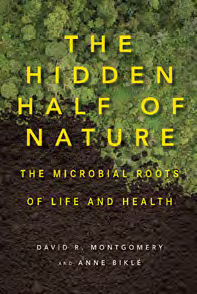SEJournal Online is the digital news magazine of the Society of Environmental Journalists. Learn more about SEJournal Online, including submission, subscription and advertising information.

BookShelf
"The Hidden Half of Nature: The Microbial Roots of Life and Health"
By David R. Montgomery and Anne Biklé
W.W. Norton, $26.95
Reviewed by JENNIFER WEEKS
Microbes have been on Earth far longer than humans, but we are just starting to understand how extensively they affect our lives.
In “The Hidden Half of Nature,” geologist David R. Montgomery and biologist Anne Biklé draw parallels between two zones where microbes make life possible: soil health and human health.
The story opens when Montgomery and Biklé, who are married, buy a house in Seattle with a rundown yard. Biklé wants to create a garden, but they find that their property has only a thin layer of weathered topsoil over clay and till (a mix of rocks and gravel left behind by melting glaciers).
Over several years, Biklé creates new soil by collecting and spreading huge amounts of organic materials — wood chips, leaves, espresso grounds from local coffee shops.
She waters it with “soil soup,” also known to gardeners as compost tea, a mix of water, compost and simple carbohydrate sources such as molasses to feed the microbes. The soil darkens and starts to come alive with worms, beetles and fungi, and Biklé’s plants thrive.
Although Montgomery and Biklé are both scientists, they are amazed by the transformation they see. “Changing soil in such a short time wasn’t supposed to be possible,” they write. “Nothing we’d learned in college and graduate school suggested the potential to so effectively bypass the achingly long process nature goes through to make soil.”
Reviewing classic studies on soil fertility explains what happened: Adding organic material promoted microbial activity, which promoted plant growth, which produced more organic material.
“In short order, bringing back life below ground triggered an explosion of life above ground,” they conclude.
Then the plot twists: Biklé is diagnosed with cervical cancer.
Instead of chemotherapy and radiation she chooses a radical hysterectomy. To recover from the surgery and the premature menopause it triggers, she consults with a naturopathic oncologist. Her doctor remakes Biklé’s (and Montgomery’s) diet, cutting down on caffeine, alcohol, sugar and refined carbs and increasing their intake of fruits and vegetables.
The goal is to strengthen Biklé’s immune system and minimize inflammation. This sends them on a new foray to understand how microbes within the human body help maintain our health.
“The human body is one vast ecosystem. Actually, it’s more like an entire planet with a rich palette of ecosystems, as different as the Serengeti and the Amazon, each hosting multitudes of microbes,” they wrote.
As Montgomery and Biklé work through research on the human microbiome (a fast-evolving field), they see that microbes play the same essential role in soil health and human health.
Microbes in the human gut pull nutrients out of the foods we eat. They also prime and train our immune systems. And like soil microbes, the microbes in our bodies thrive on certain kinds of food — mainly plants, beans and whole grains, with modest amounts of meat and healthy fats.
The authors tie these two strands together with a discussion of how we think about microbes. Before the germ theory of disease was developed in the late 1800s, people thought illness was caused by all kinds of things, from breathing bad air to thinking immoral thoughts.
By explaining that the real causes were bacteria and viruses, germ theory laid the ground for modern medicine. But Montgomery and Biklé worry that we have learned the lesson too well.
“It turns out we need most of the microbes we’ve been trying so hard to kill,” they wrote.
To correct the balance they call for more selective use of antibiotics and less obsession with sterilizing our bodies and homes. In agriculture, overuse of pesticides harms many of the microbes that make soil healthy, and eventually creates resistant pests.
This engaging book has a great introduction to microbial science, with a helpful glossary. Montgomery and Biklé urge readers to appreciate how the “hidden half of nature” shapes our lives, and to be aware that we reap what we feed our inner and outer soil.
Jennifer Weeks is a Massachusetts-based freelance writer and former SEJ board member.
* From the quarterly newsletter SEJournal, Winter 2015/2016. Each new issue of SEJournal is available to members and subscribers only; find subscription information here or learn how to join SEJ. Past issues are archived for the public here.











 Advertisement
Advertisement 



